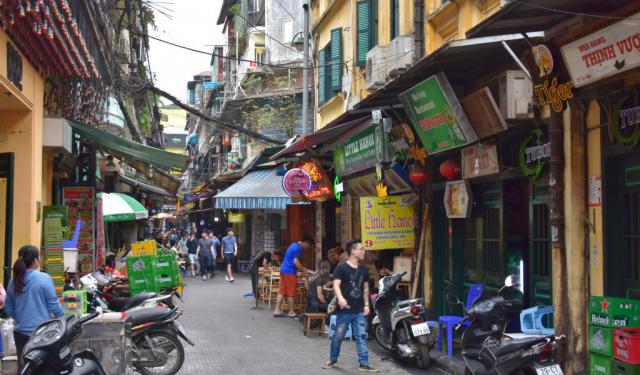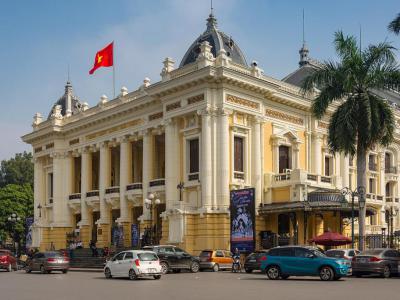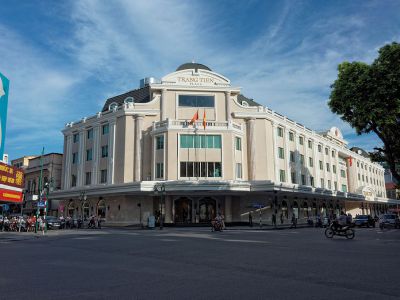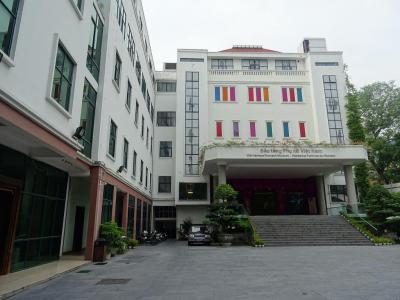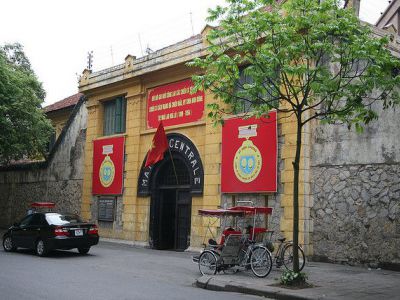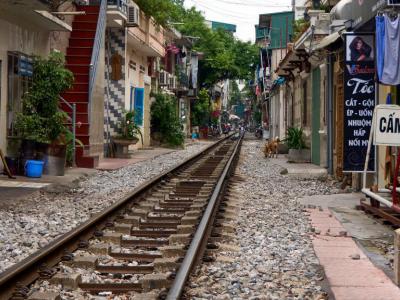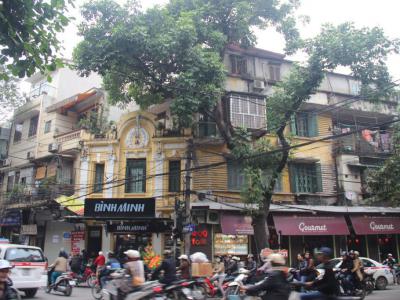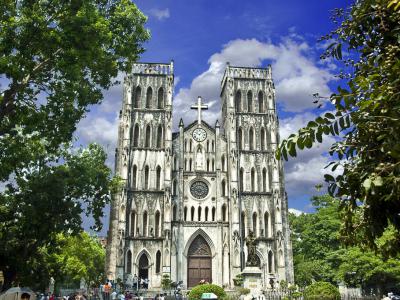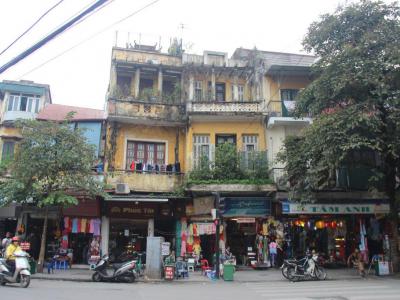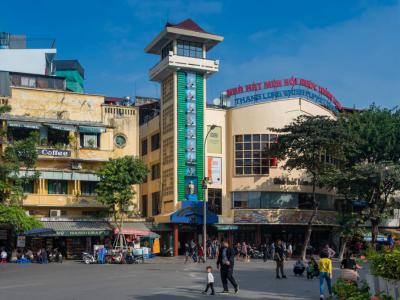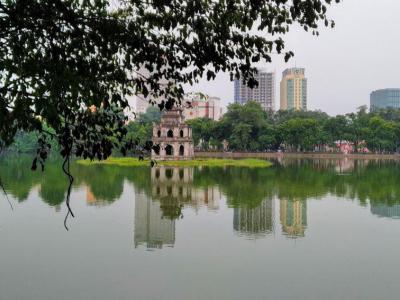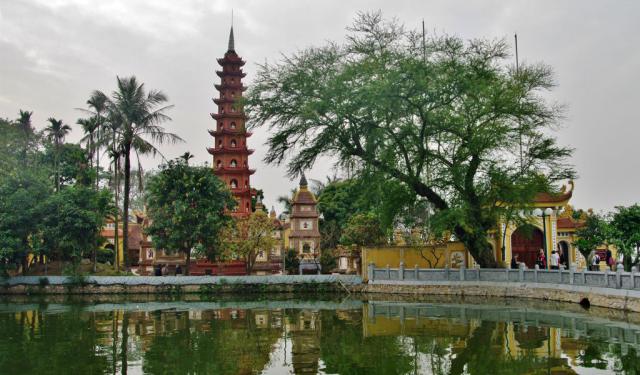Hanoi's Old Quarter Walking Tour (Self Guided), Hanoi
The Old Quarter (Vietnamese: Phố cổ Hà Nội) is the name commonly given to the historical civic urban core of the city, located outside the Imperial Citadel of Thăng Long in the northern half of Hoàn Kiếm District, renowned for its small street blocks and alleys, and a traditional Vietnamese atmosphere.
During the Lê dynasty (1428-1789), the area included several lakes and wetlands connected with the Hoàn Kiếm lake and the Red River. Another common name referring to approximately the same area is the 36 streets (Vietnamese: Hà Nội 36 phố phường), after the 36 streets or guilds that once made up the district. Each such street housed merchants specialized in a particular trade. The street names here still reflect these specializations, such as Hàng Bông (Cotton Street), Hàng Gai (Silk or Hemp Street) and so on.
More than six decades of French colonization, from the late 1800s until 1954, and centuries of socio-cultural influence from China are duly reflected in the designs of Old Quarter's houses. The Franco-Chinese hybrid architecture marries French-styled columns with Confucian scrolls, Taoist yin-yang signs and Buddhist lotus sculpture. Many local structures carry a great deal of French charm, with some of them closely resembling famous Parisian landmarks, like the Hanoi Opera House (resembling Palais Garnier) and St. Joseph Cathedral (resembling the Notre Dame de Paris).
The variety of entertainment options found in Hanoi is vast. A popular traditional form of entertainment, water puppetry, can be seen at the Thăng Long Water Puppet Theatre.
The Old Quarter of Hanoi is an intriguing neighborhood, home to a mix of everything – architecture, greenery, ancient shops and fresh-as-it-gets street food - all of which can be easily explored on foot. If you wish to get a first-hand experience of it yourself, take this self-guided walking tour.
During the Lê dynasty (1428-1789), the area included several lakes and wetlands connected with the Hoàn Kiếm lake and the Red River. Another common name referring to approximately the same area is the 36 streets (Vietnamese: Hà Nội 36 phố phường), after the 36 streets or guilds that once made up the district. Each such street housed merchants specialized in a particular trade. The street names here still reflect these specializations, such as Hàng Bông (Cotton Street), Hàng Gai (Silk or Hemp Street) and so on.
More than six decades of French colonization, from the late 1800s until 1954, and centuries of socio-cultural influence from China are duly reflected in the designs of Old Quarter's houses. The Franco-Chinese hybrid architecture marries French-styled columns with Confucian scrolls, Taoist yin-yang signs and Buddhist lotus sculpture. Many local structures carry a great deal of French charm, with some of them closely resembling famous Parisian landmarks, like the Hanoi Opera House (resembling Palais Garnier) and St. Joseph Cathedral (resembling the Notre Dame de Paris).
The variety of entertainment options found in Hanoi is vast. A popular traditional form of entertainment, water puppetry, can be seen at the Thăng Long Water Puppet Theatre.
The Old Quarter of Hanoi is an intriguing neighborhood, home to a mix of everything – architecture, greenery, ancient shops and fresh-as-it-gets street food - all of which can be easily explored on foot. If you wish to get a first-hand experience of it yourself, take this self-guided walking tour.
How it works: Download the app "GPSmyCity: Walks in 1K+ Cities" from Apple App Store or Google Play Store to your mobile phone or tablet. The app turns your mobile device into a personal tour guide and its built-in GPS navigation functions guide you from one tour stop to next. The app works offline, so no data plan is needed when traveling abroad.
Hanoi's Old Quarter Walking Tour Map
Guide Name: Hanoi's Old Quarter Walking Tour
Guide Location: Vietnam » Hanoi (See other walking tours in Hanoi)
Guide Type: Self-guided Walking Tour (Sightseeing)
# of Attractions: 10
Tour Duration: 2 Hour(s)
Travel Distance: 4.0 Km or 2.5 Miles
Author: HelenF
Sight(s) Featured in This Guide:
Guide Location: Vietnam » Hanoi (See other walking tours in Hanoi)
Guide Type: Self-guided Walking Tour (Sightseeing)
# of Attractions: 10
Tour Duration: 2 Hour(s)
Travel Distance: 4.0 Km or 2.5 Miles
Author: HelenF
Sight(s) Featured in This Guide:
- Hanoi Opera House
- Trang Tien Plaza
- Museum of Vietnamese Women
- Hoa Lo Prison
- The Train Street
- Hang Bong Street
- St. Joseph Cathedral
- Hàng Gai (Silk Street)
- Water Puppet Theater
- Hoàn Kiếm Lake
1) Hanoi Opera House
The Hanoi opera house was built in 1911 by the French colonial rulers to resemble the old opera house in Paris. On August the 16th 1945, the Viet Minh declared that it had taken over the city from the balcony of the building.
The Hanoi opera house was built over a drained pond in 1911. Architects Harley and Broyer were the designers, and the construction was supervised by M. Travary and M. Savelon. The structure combines Greek, Beaux Arts and Gothic styles like the Palais Garnier, the old opera house in Paris. This is the largest theater in Vietnam. It consists of a large stage, a 24 x 24 meter main audience room and several balconies in the middle floor. There are 18 makeup rooms, 2 rooms for voice training, a library and a meeting room backstage. In 1997, the opera house underwent major restoration under the supervision of French Vietnamese architects, Ho Thieu Thri and Hoang Phuc Sinh. The theater was equipped with state of the art acoustic and other equipment suitable for modern audiences.
Visitors can view all types of performances at the Hanoi opera house including folk music performances, western music concerts and Vietnamese operetta and drama. Visitors are not allowed in unless they are part of the audience at a performance. The steps leading to the building are a popular place for tourists to get their photographs taken.
The Hanoi opera house was built over a drained pond in 1911. Architects Harley and Broyer were the designers, and the construction was supervised by M. Travary and M. Savelon. The structure combines Greek, Beaux Arts and Gothic styles like the Palais Garnier, the old opera house in Paris. This is the largest theater in Vietnam. It consists of a large stage, a 24 x 24 meter main audience room and several balconies in the middle floor. There are 18 makeup rooms, 2 rooms for voice training, a library and a meeting room backstage. In 1997, the opera house underwent major restoration under the supervision of French Vietnamese architects, Ho Thieu Thri and Hoang Phuc Sinh. The theater was equipped with state of the art acoustic and other equipment suitable for modern audiences.
Visitors can view all types of performances at the Hanoi opera house including folk music performances, western music concerts and Vietnamese operetta and drama. Visitors are not allowed in unless they are part of the audience at a performance. The steps leading to the building are a popular place for tourists to get their photographs taken.
2) Trang Tien Plaza
Trang Tien Plaza is a major shopping center located in the Hoan Kiem district of Hanoi. It occupies the former site of the Hanoi General Department Store, near the Hanoi Post Office, and has a view of Hoan Kiem Lake. Trang Tien Plaza is not just one of the city's biggest and most upscale malls, but it's also a key landmark. The building, which showcases sophisticated French architectural design, reflects the refined culture of Vietnam's capital. It features over 215,000 square feet of space, which includes offices, retail stores, and various dining and cafe options.
The origins of this esteemed shopping destination trace back to 1953, when the French government sold what was known as Maison Godard to international businesses, renaming it Grands Magasins Reunis. By 1959, it was renamed again to the General Department Store of Hanoi City, selling items such as textiles, clothes, bicycles, and their parts. In 1993, the Vietnamese government acquired it, but the state-run business closed on September 29, 1995.
Construction of the new complex began on April 30, 2000, commemorating the 25th anniversary of South Vietnam's liberation, and was completed in 18 months by another state enterprise. This led to the opening of the modern Trang Tien Plaza, which provides a wide range of products, from everyday items to luxury goods. By 2005, thanks to substantial investments from IMEX PAN Pacific Group, it became the nation’s premier luxury shopping destination.
Today, Trang Tien Plaza hosts over 200 global brands including Rolex, Burberry, and Zegna. The first floor features top-tier brands like Louis Vuitton and Cartier, while the second floor offers labels such as Versace and Dior. The third floor focuses on jewelry and beauty products, the fourth floor caters to men's and women’s fashion and accessories, and the fifth floor includes a cinema and restaurant. The sixth floor is dedicated to home goods and children's products.
The origins of this esteemed shopping destination trace back to 1953, when the French government sold what was known as Maison Godard to international businesses, renaming it Grands Magasins Reunis. By 1959, it was renamed again to the General Department Store of Hanoi City, selling items such as textiles, clothes, bicycles, and their parts. In 1993, the Vietnamese government acquired it, but the state-run business closed on September 29, 1995.
Construction of the new complex began on April 30, 2000, commemorating the 25th anniversary of South Vietnam's liberation, and was completed in 18 months by another state enterprise. This led to the opening of the modern Trang Tien Plaza, which provides a wide range of products, from everyday items to luxury goods. By 2005, thanks to substantial investments from IMEX PAN Pacific Group, it became the nation’s premier luxury shopping destination.
Today, Trang Tien Plaza hosts over 200 global brands including Rolex, Burberry, and Zegna. The first floor features top-tier brands like Louis Vuitton and Cartier, while the second floor offers labels such as Versace and Dior. The third floor focuses on jewelry and beauty products, the fourth floor caters to men's and women’s fashion and accessories, and the fifth floor includes a cinema and restaurant. The sixth floor is dedicated to home goods and children's products.
3) Museum of Vietnamese Women (must see)
The Museum of Vietnamese Women, located in a leafy courtyard in Ly Thuong Kiet Street in Hanoi is one of the few museums in the world dedicated solely to the life and achievements of women. The museum is a tribute to the sacrifices and contributions made by women to society and to the country of Vietnam.
The idea of establishing a museum dedicated to women was that of Vietnam Women’s Union president Nguyen Thi Dinh and the collections are the result of ten years of patient research. The building was designed by a lady architect, Tran Xuan Diem.
Visitors are welcomed in the first section of the museum by 3.6 meter high statue dedicated to the Vietnamese mother. The sculpture by Phu Cuong is cast in pure gold. Another section shows the contribution of women in the construction of modern Vietnam and their services in defending the nation. The walls are covered with photographs of women taking active part in all professional fields like education, industry, transport and healthcare in Vietnam. There is also a section devoted to the achievements of the Women’s workers union, a 65 year old institution that has taken an active part in the building of the nation.
A popular section is the collection of costumes worn by women from 54 nationalities that make up Vietnam. There is also a gift shop and café for the convenience of visitors.
The idea of establishing a museum dedicated to women was that of Vietnam Women’s Union president Nguyen Thi Dinh and the collections are the result of ten years of patient research. The building was designed by a lady architect, Tran Xuan Diem.
Visitors are welcomed in the first section of the museum by 3.6 meter high statue dedicated to the Vietnamese mother. The sculpture by Phu Cuong is cast in pure gold. Another section shows the contribution of women in the construction of modern Vietnam and their services in defending the nation. The walls are covered with photographs of women taking active part in all professional fields like education, industry, transport and healthcare in Vietnam. There is also a section devoted to the achievements of the Women’s workers union, a 65 year old institution that has taken an active part in the building of the nation.
A popular section is the collection of costumes worn by women from 54 nationalities that make up Vietnam. There is also a gift shop and café for the convenience of visitors.
4) Hoa Lo Prison (must see)
The Hoa Lo prison in Hanoi, sarcastically referred to as the Hanoi Hilton by American POWs in the 2nd Indochina War, is a vast prison complex built by the French in the style of the Maison Centrales a euphemism used for prisons in France. At first it was used as a prison, detention and torture center for revolutionaries struggling for independence from France. During the Vietnam War, the prison was used to house several American pilots whose planes were shot down by Vietnamese forces.
The Hoa Lo prison was built by the French between 1886 and 1901. Hoa Lo means fiery furnace or stove in Vietnamese. The facility was built to house 450 inmates. During the freedom struggle, the prison had more than 2000 Vietnamese inmates living in sub human conditions. Several tools of torture used by the French are preserved including a Guillotine used to behead early Vietnamese freedom fighters. From 1964 to 1973, the prison was a major POW detention facility and earned its name, the Hanoi Hilton. Well known inmates included Senator John McCain, the 2008 Presidential nominee of the Republican Party and Pete Peterson, who later became ambassador to Vietnam.
A small part of the original facility is preserved. The other part has now become a modern office and residential complex called the Hanoi Towers. Hanoi Hilton is located near the French quarter.
The Hoa Lo prison was built by the French between 1886 and 1901. Hoa Lo means fiery furnace or stove in Vietnamese. The facility was built to house 450 inmates. During the freedom struggle, the prison had more than 2000 Vietnamese inmates living in sub human conditions. Several tools of torture used by the French are preserved including a Guillotine used to behead early Vietnamese freedom fighters. From 1964 to 1973, the prison was a major POW detention facility and earned its name, the Hanoi Hilton. Well known inmates included Senator John McCain, the 2008 Presidential nominee of the Republican Party and Pete Peterson, who later became ambassador to Vietnam.
A small part of the original facility is preserved. The other part has now become a modern office and residential complex called the Hanoi Towers. Hanoi Hilton is located near the French quarter.
5) The Train Street
Ngõ 224 Lê Duẩn, situated within Hanoi’s Old Quarter, is famously dubbed as "The Train Street". This narrow alley witnesses a speeding train passing by twice a day, perilously close to the buildings flanking the tracks, which almost entirely occupy the alley. Constructed by the French in 1902, this railway line remains operational as of 2019.
The train whizzes through at 3 pm and 7 pm daily, traversing the route between Hanoi and Ho Chi Minh City to the south. Due to the alley's cramped dimensions, residents are compelled to clear away their personal belongings, including bicycles and even children, before the train's passage. It's a common sight to see locals leisurely seated on the tracks, savoring tea and engaging in games of checkers.
This peculiar street has garnered attention as a tourist attraction in Hanoi. However, in October 2019, local authorities, citing safety concerns and the potential for grave accidents, barred tourists from accessing the area. Tourists frequently halted to capture photographs for social media amidst the narrow confines of the alley. Over time, the street had become a residence for squatters and a haunt for drug addicts, alongside the presence of numerous cafes and residential buildings. The congestion eventually led to the rerouting of a local train on October 6, 2019, prompting the closure of the alley.
To cater to the bustling tourist influx, local cafes have flourished along the street. Owners fret over the impending loss of business due to the closure. According to the VN Express newspaper, a train driver recounted three near-misses with tourists on the tracks, narrowly averting catastrophe, with one incident involving a woman engrossed in photographing the passing train.
For tourists seeking a safe vantage point, outdoor seating areas of the local cafes offer a secure option. Cafe proprietors typically shift their stools closer to the walls and advise patrons to do the same as the train approaches. Many cafes also display train schedules on chalkboards for the convenience of their customers.
The train whizzes through at 3 pm and 7 pm daily, traversing the route between Hanoi and Ho Chi Minh City to the south. Due to the alley's cramped dimensions, residents are compelled to clear away their personal belongings, including bicycles and even children, before the train's passage. It's a common sight to see locals leisurely seated on the tracks, savoring tea and engaging in games of checkers.
This peculiar street has garnered attention as a tourist attraction in Hanoi. However, in October 2019, local authorities, citing safety concerns and the potential for grave accidents, barred tourists from accessing the area. Tourists frequently halted to capture photographs for social media amidst the narrow confines of the alley. Over time, the street had become a residence for squatters and a haunt for drug addicts, alongside the presence of numerous cafes and residential buildings. The congestion eventually led to the rerouting of a local train on October 6, 2019, prompting the closure of the alley.
To cater to the bustling tourist influx, local cafes have flourished along the street. Owners fret over the impending loss of business due to the closure. According to the VN Express newspaper, a train driver recounted three near-misses with tourists on the tracks, narrowly averting catastrophe, with one incident involving a woman engrossed in photographing the passing train.
For tourists seeking a safe vantage point, outdoor seating areas of the local cafes offer a secure option. Cafe proprietors typically shift their stools closer to the walls and advise patrons to do the same as the train approaches. Many cafes also display train schedules on chalkboards for the convenience of their customers.
6) Hang Bong Street (must see)
Hàng Bông (French: Rue du Coton) is an ancient street running for about 932 meters from the crossroad Hàng Bông - Hàng Gai - Hàng Trong - Hàng Hom to the former city gate Cửa Nam (South Gate). Once populated by cotton dealers and makers of clothes and winter blankets (hence the name), today's Hàng Bông is one of the busiest shopping streets in Hanoi, lined with art galleries, silk and clothing shops.
Formerly this street consisted of various sections, each with its own name, such as Hang Hai (aka Hang Bong Hai), Hang Manh (packed with shops selling comedy shoes, hats, and paper worship items), Hang Bong Dem (inhabited by sellers of cotton balls, cotton- and other blankets), Hang Bong Banyan Tree Cua Quyen (home to a small temple worshiping Co Quyen, with a banyan tree nearby), Hang Bong Lo (where all kinds of fish were sold), Hang Bong Tho Nhuom (back in the early 20th century this was home to the dyers of silk fabrics), and Hang Bong Alley (known during the French colonial era as Rue Lhonde).
Also, during the French period, Old Hang Bong Street was a home to many print houses, bookstores, and journalists. Notorious for many traffic accidents involving trams (prior to 1991), Hang Bong Street, since the turn of the 21st century, has been gradually associated with luxurious fashion, largely surpassing the rival destinations of Hang Dao, Luong Van Can and Tran Nhan Tong streets. Today, this street also accommodates the fancy Silk Path hotel where once used to be the music tea rooms, popular haunt for artists and other creative folk.
At night, Hang Bong Street is a popular gathering spot for youngsters and students, in large part due to the cheap fried and grilled spring rolls sold on the corner of Hang Bong junction and Tam Thuong alley. At the end of the street, on the right-hand (even-numbered) side is a pastry shop very famous with backpackers. On festive occasions, this street is also teeming with sellers of flags and T-shirts.
Formerly this street consisted of various sections, each with its own name, such as Hang Hai (aka Hang Bong Hai), Hang Manh (packed with shops selling comedy shoes, hats, and paper worship items), Hang Bong Dem (inhabited by sellers of cotton balls, cotton- and other blankets), Hang Bong Banyan Tree Cua Quyen (home to a small temple worshiping Co Quyen, with a banyan tree nearby), Hang Bong Lo (where all kinds of fish were sold), Hang Bong Tho Nhuom (back in the early 20th century this was home to the dyers of silk fabrics), and Hang Bong Alley (known during the French colonial era as Rue Lhonde).
Also, during the French period, Old Hang Bong Street was a home to many print houses, bookstores, and journalists. Notorious for many traffic accidents involving trams (prior to 1991), Hang Bong Street, since the turn of the 21st century, has been gradually associated with luxurious fashion, largely surpassing the rival destinations of Hang Dao, Luong Van Can and Tran Nhan Tong streets. Today, this street also accommodates the fancy Silk Path hotel where once used to be the music tea rooms, popular haunt for artists and other creative folk.
At night, Hang Bong Street is a popular gathering spot for youngsters and students, in large part due to the cheap fried and grilled spring rolls sold on the corner of Hang Bong junction and Tam Thuong alley. At the end of the street, on the right-hand (even-numbered) side is a pastry shop very famous with backpackers. On festive occasions, this street is also teeming with sellers of flags and T-shirts.
7) St. Joseph Cathedral
Saint Joseph's Cathedral in Hanoi serves as the seat of the Roman Catholic Archdiocese of Hanoi. Constructed in 1886 during French colonial rule, it is the oldest church in the city. Locally known as the "Big Church," it is situated on Nha Chung Street, close to the Ho Hoan Kiem, also known as the Lake of the Returned Sword.
The cathedral's location has a significant historical backdrop, as it was built on the site of the demolished Bao Thien Pagoda, a 12th-century temple constructed by the Ly Dynasty and formerly a vital place of worship for the local populace. This decision by the French to replace the pagoda highlighted their influence and architectural ambitions in Hanoi during their colonial tenure.
Saint Joseph's Cathedral was consecrated on Christmas Day, 1886, and features a neo-Gothic architectural style, mirroring the iconic Notre Dame Cathedral in Paris. This style is evident in its facade, characterized by twin towers flanked by impressive stained glass windows. These windows allow light to filter through in a myriad of colors, creating a visually captivating effect.
In front of the cathedral stands the Regina Pacis (Queen of Peace) statue of the Virgin Mary, adding to its spiritual and architectural significance. Inside, the cathedral is renowned for its beautiful interiors, which visitors can admire through a side door entry.
Mass is conducted twice daily at Saint Joseph's Cathedral, with increased attendance on Sundays and holidays, reflecting its central role in the religious life of the community. The cathedral remains a popular destination for both worshippers and tourists, offering a glimpse into the spiritual and colonial history of Hanoi.
The cathedral's location has a significant historical backdrop, as it was built on the site of the demolished Bao Thien Pagoda, a 12th-century temple constructed by the Ly Dynasty and formerly a vital place of worship for the local populace. This decision by the French to replace the pagoda highlighted their influence and architectural ambitions in Hanoi during their colonial tenure.
Saint Joseph's Cathedral was consecrated on Christmas Day, 1886, and features a neo-Gothic architectural style, mirroring the iconic Notre Dame Cathedral in Paris. This style is evident in its facade, characterized by twin towers flanked by impressive stained glass windows. These windows allow light to filter through in a myriad of colors, creating a visually captivating effect.
In front of the cathedral stands the Regina Pacis (Queen of Peace) statue of the Virgin Mary, adding to its spiritual and architectural significance. Inside, the cathedral is renowned for its beautiful interiors, which visitors can admire through a side door entry.
Mass is conducted twice daily at Saint Joseph's Cathedral, with increased attendance on Sundays and holidays, reflecting its central role in the religious life of the community. The cathedral remains a popular destination for both worshippers and tourists, offering a glimpse into the spiritual and colonial history of Hanoi.
8) Hàng Gai (Silk Street)
Set on the edge of Hanoi’s Old Quarter, near Hoan Kiem Lake, Hang Gai or Silk Street is one of the most bustling commercial destinations in the capital, specialized in silk. The entirety of this 300 meter-long street is lined with more than a hundred stores trading in silk or related products and services. The vast majority of the local fashion boutiques and tailor shops have been in business for decades, offering ready-to-wear and made-to-measure garments.
Back in the times of the Le Dynasty (1428-1789), Hang Gai (literally “Hemp Street”) was the middle section of the road that linked the Nhi Ha river shore to the Southern Gate of Thang Long imperial citadel, and was the place were ropes and hammocks were sold. The word “Gai” in Vietnamese means hemp that was used in making of the hammocks. Similarly, during the French colonial era, Hang Gai was known as Rue de Chanvre (chanvre is the French for hemp, too).
Generally renowned for its quality, the area has a number of firm favourites among the clientele, such as the Khai Silk and Tan My Design shops whose craftsmen are perfect if you’re too pressed for time to get a tailor-made outfit during your stay in Hanoi. They can make you a suit within 24 hours, though it’s best to allow more time for a second fitting to make sure that it fits perfectly.
Most stores in Hang Gai Street accept cards and it pays to go to a better quality store and avoid street vendors to ensure the best buy. As with most retailers throughout Vietnam, bargaining is also welcome – you can start at 50% off the asking price and pay no more than 70%.
Aside from boutiques and tailor shops, Hang Gai Street also hosts a number of souvenir outlets selling notebooks, lamps and postcards, as well as prominent art galleries such as Thang Long Art Gallery and Green Palm Gallery.
Back in the times of the Le Dynasty (1428-1789), Hang Gai (literally “Hemp Street”) was the middle section of the road that linked the Nhi Ha river shore to the Southern Gate of Thang Long imperial citadel, and was the place were ropes and hammocks were sold. The word “Gai” in Vietnamese means hemp that was used in making of the hammocks. Similarly, during the French colonial era, Hang Gai was known as Rue de Chanvre (chanvre is the French for hemp, too).
Generally renowned for its quality, the area has a number of firm favourites among the clientele, such as the Khai Silk and Tan My Design shops whose craftsmen are perfect if you’re too pressed for time to get a tailor-made outfit during your stay in Hanoi. They can make you a suit within 24 hours, though it’s best to allow more time for a second fitting to make sure that it fits perfectly.
Most stores in Hang Gai Street accept cards and it pays to go to a better quality store and avoid street vendors to ensure the best buy. As with most retailers throughout Vietnam, bargaining is also welcome – you can start at 50% off the asking price and pay no more than 70%.
Aside from boutiques and tailor shops, Hang Gai Street also hosts a number of souvenir outlets selling notebooks, lamps and postcards, as well as prominent art galleries such as Thang Long Art Gallery and Green Palm Gallery.
9) Water Puppet Theater
The Thang Long Water Puppet Theater in Hanoi seeks to preserve an ancient Vietnamese art form developed in the Red River delta in North Vietnam. Water puppetry or Mua Roi Nuoc was performed in shallow flooded paddy fields and ponds of the Red River delta. The theater is a well known Vietnamese cultural event and theater troupes have travelled around the world and performed at cultural exchanges and art festivals.
The puppets are mounted on poles hidden under a shallow pool of water. There are performances that portray life in a typical Vietnamese village. Elaborate performances tell tales from legends and myths of rural Vietnam. The brightly colored puppets are made of lacquered wood. The unique special effects of light and water make the show unique. The performance is accompanied by an orchestra that uses traditional Vietnamese musical instruments like drums, flutes, drums and the Dan Bau that resembles a harp. Songs are sung during the performance and stories are told in the native tongue. The puppets are expressive and one does not need to know the language to enjoy the story. Well known performances include the Dance of the Fairies, Dance of the Dragons and the Legend of the Restored Sword.
Each show lasts for about one hour. Cameras are allowed and visitors are sometimes given cds of the music or vcds of the performance when they purchase tickets.
The puppets are mounted on poles hidden under a shallow pool of water. There are performances that portray life in a typical Vietnamese village. Elaborate performances tell tales from legends and myths of rural Vietnam. The brightly colored puppets are made of lacquered wood. The unique special effects of light and water make the show unique. The performance is accompanied by an orchestra that uses traditional Vietnamese musical instruments like drums, flutes, drums and the Dan Bau that resembles a harp. Songs are sung during the performance and stories are told in the native tongue. The puppets are expressive and one does not need to know the language to enjoy the story. Well known performances include the Dance of the Fairies, Dance of the Dragons and the Legend of the Restored Sword.
Each show lasts for about one hour. Cameras are allowed and visitors are sometimes given cds of the music or vcds of the performance when they purchase tickets.
10) Hoàn Kiếm Lake (must see)
Hoàn Kiếm Lake holds a storied place at the heart of Hanoi. Also known as Sword Lake, this 12-hectare freshwater lake is a central feature of the city's public and historical life. Located in Hanoi's historical center, the lake is not only a major scenic spot but also a focal point for the city's public life, surrounded by vibrant streets and bustling local markets.
Originally named Green Water Lake (Hồ Lục Thủy) for its distinctive watercolor, the lake's present name, which means "Lake of the Returned Sword," is derived from a legendary event. The tale recounts that Emperor Lê Lợi, after defeating Ming China, was approached by a Golden Turtle God (Kim Qui) while boating on the lake. The turtle god requested the return of a magical sword, Heaven's Will, given to Lợi by the Dragon King (Long Vương) to aid in his battle against the Chinese. Acknowledging that his mission was accomplished, Lợi returned the sword to the turtle. This pivotal event led to the renaming of the lake to commemorate the sword's return.
The Turtle Tower (Tháp Rùa), situated on a small island near the center of the lake, is a prominent landmark associated with this legend. It stands as a silent reminder of the lake's mythological past. The lake was once home to the large soft-shell turtle species Rafetus leloi, named in honor of the emperor. Although the last known specimen was found deceased in 2016, the species remains emblematic of the lake's rich biodiversity.
To the north, the Jade Islet is connected to the lake's shore by the striking vermilion-red Thê Húc Bridge, which means "Perch of the Morning Sunlight". Atop the islet sits the Temple of the Jade Mountain (Ngoc Son), erected in the 18th century. This temple honors notable historical figures such as Tran Hung Dao, a military leader known for his victories over Mongol invaders; Van Xuong, a revered scholar; and Nguyen Van Sieu, a renowned writer who refurbished the temple in 1864, lending it its current appearance.
Today, Hoàn Kiếm Lake remains a vital part of Hanoi’s cultural fabric, attracting visitors with its serene beauty and rich history, encapsulating a blend of natural charm and cultural significance.
Originally named Green Water Lake (Hồ Lục Thủy) for its distinctive watercolor, the lake's present name, which means "Lake of the Returned Sword," is derived from a legendary event. The tale recounts that Emperor Lê Lợi, after defeating Ming China, was approached by a Golden Turtle God (Kim Qui) while boating on the lake. The turtle god requested the return of a magical sword, Heaven's Will, given to Lợi by the Dragon King (Long Vương) to aid in his battle against the Chinese. Acknowledging that his mission was accomplished, Lợi returned the sword to the turtle. This pivotal event led to the renaming of the lake to commemorate the sword's return.
The Turtle Tower (Tháp Rùa), situated on a small island near the center of the lake, is a prominent landmark associated with this legend. It stands as a silent reminder of the lake's mythological past. The lake was once home to the large soft-shell turtle species Rafetus leloi, named in honor of the emperor. Although the last known specimen was found deceased in 2016, the species remains emblematic of the lake's rich biodiversity.
To the north, the Jade Islet is connected to the lake's shore by the striking vermilion-red Thê Húc Bridge, which means "Perch of the Morning Sunlight". Atop the islet sits the Temple of the Jade Mountain (Ngoc Son), erected in the 18th century. This temple honors notable historical figures such as Tran Hung Dao, a military leader known for his victories over Mongol invaders; Van Xuong, a revered scholar; and Nguyen Van Sieu, a renowned writer who refurbished the temple in 1864, lending it its current appearance.
Today, Hoàn Kiếm Lake remains a vital part of Hanoi’s cultural fabric, attracting visitors with its serene beauty and rich history, encapsulating a blend of natural charm and cultural significance.
Walking Tours in Hanoi, Vietnam
Create Your Own Walk in Hanoi
Creating your own self-guided walk in Hanoi is easy and fun. Choose the city attractions that you want to see and a walk route map will be created just for you. You can even set your hotel as the start point of the walk.
Hanoi Introduction Walking Tour
Known for its centuries-old architecture and rich culture with Southeast Asian, Chinese and French influences, the capital of Vietnam, Hanoi, traces its origin back to the third century BC. Originally, a portion of modern-day Hanoi served as the capital of the historic Vietnamese nation Âu Lạc. Following the collapse of Âu Lạc, the city was made part of Han China (111 BC-40 AD).
... view more
Tour Duration: 2 Hour(s)
Travel Distance: 4.0 Km or 2.5 Miles
... view more
Tour Duration: 2 Hour(s)
Travel Distance: 4.0 Km or 2.5 Miles
The Most Popular Cities
/ view all
